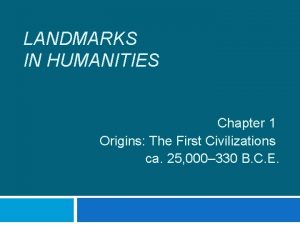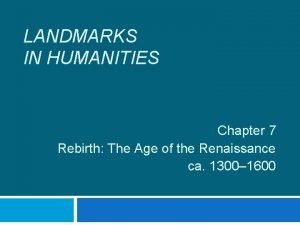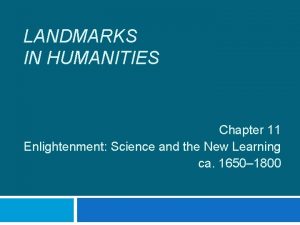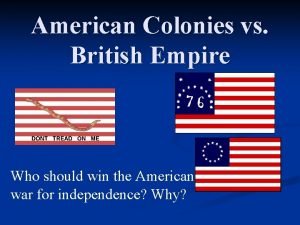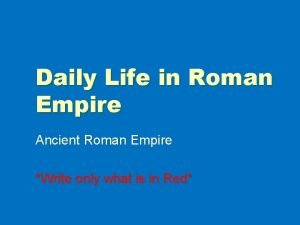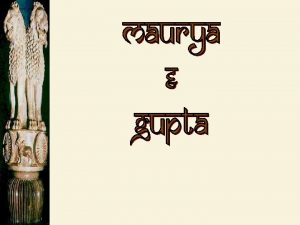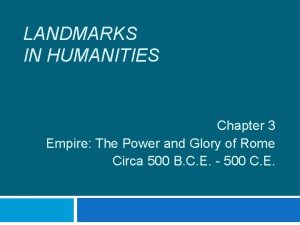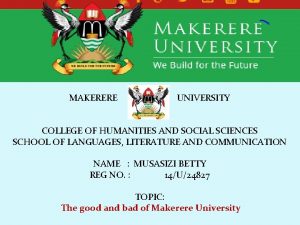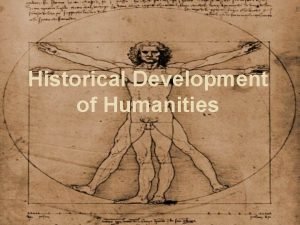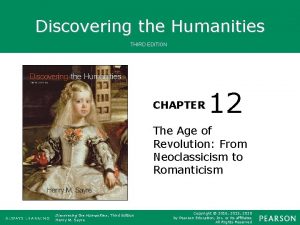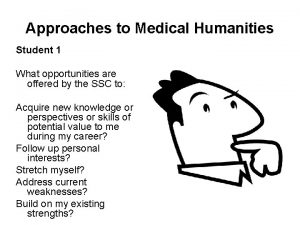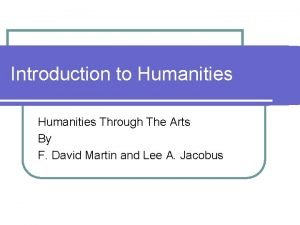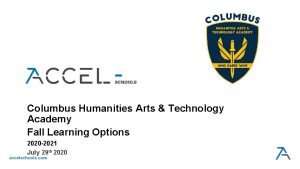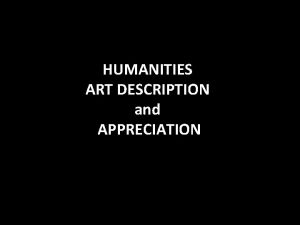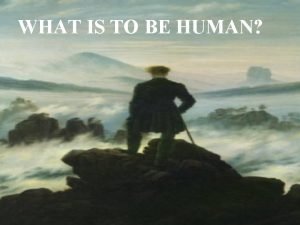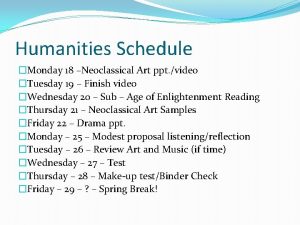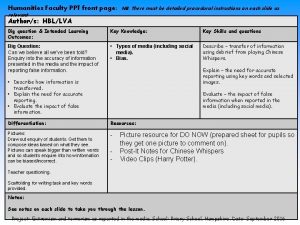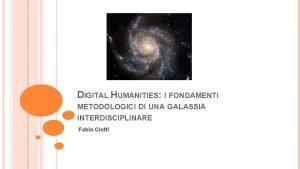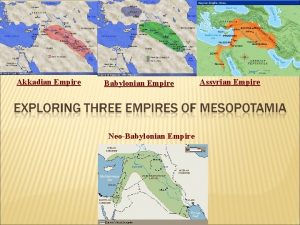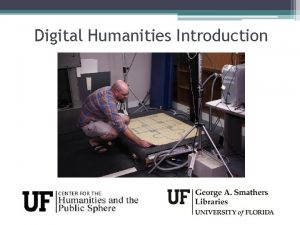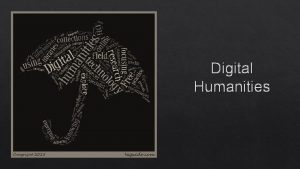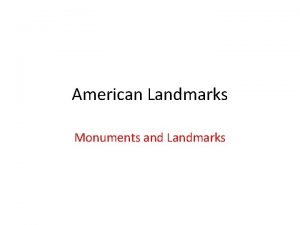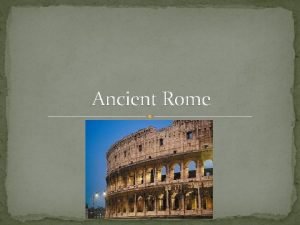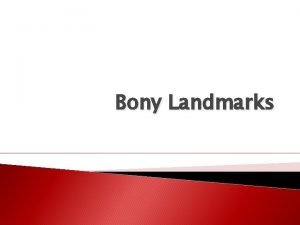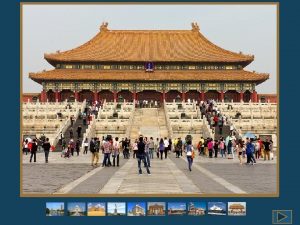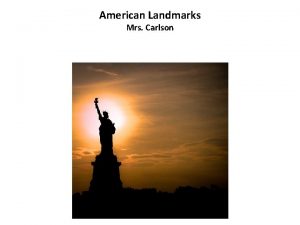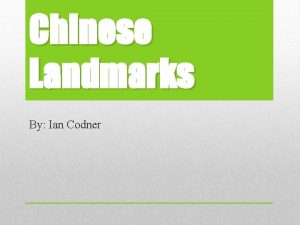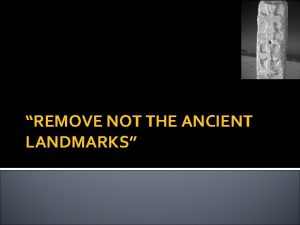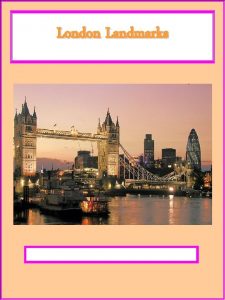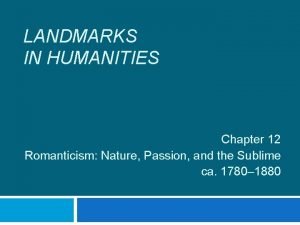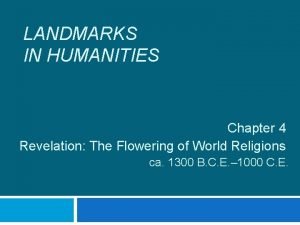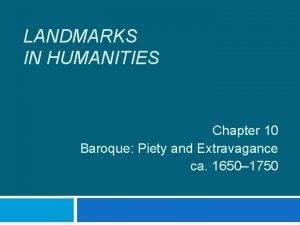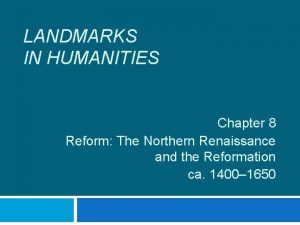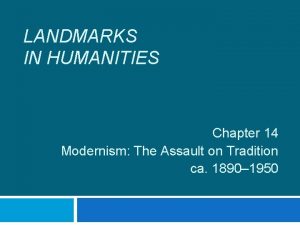LANDMARKS IN HUMANITIES Chapter 3 Empire The Power





























- Slides: 29

LANDMARKS IN HUMANITIES Chapter 3 Empire: The Power and Glory of Rome Circa 500 B. C. E. - 500 C. E.

The Roman Rise to Empire (1) 2 Rome’s Early History Rome, central Italy settled by Iron Age tribe: the Latins Rest of Italy settled by Etruscans, Greeks, Phoenicians Latins absorbed culture of other peoples Etruscans: urban planning; the arch; sarcophagi art Greeks: gods and goddesses; Classical style © 2016, The Mc. Graw-Hill Companies, Inc. All Rights Reserved.

The Roman Rise to Empire (2) 3 The Roman Republic (509– 133 B. C. E. ) 509 B. C. E. , Latins overthrew Etruscan rule Res publica Popular Assembly Made up of plebeians; power vested in two elected magistrates Senate Made up of the wealthy patricians; controlled lawmaking Plebeians increased their political influence Given privilege of making laws, 287 B. C. E. © 2016, The Mc. Graw-Hill Companies, Inc. All Rights Reserved.

The Roman Rise to Empire (3) 4 Rome adopted expansionist course United all of Italy by force or negotiation Punic Wars ended with destruction of Carthage in 146 B. C. E. Mare nostrum By end of first century B. C. E. , Roman Empire included much of present-day Europe, North Africa, and southwest Asia Efficient administrators Disciplined army was backbone of the Empire © 2016, The Mc. Graw-Hill Companies, Inc. All Rights Reserved.

The Roman Rise to Empire (4) 5 © 2016, The Mc. Graw-Hill Companies, Inc. All Rights Reserved.

The Roman Rise to Empire (5) 6 The Collapse of the Republic (133– 30 B. C. E) Roman imperialism changed the Republic Rich grew richer, poorer Senate, army grew more powerful Latifundia worked by slaves increased agricultural productivity and drove small farmers out of business Reform measures failed; first century B. C. E. , age of military dictators 46 B. C. E. , Gaius Julius Caesar entered Rome and established dictatorship © 2016, The Mc. Graw-Hill Companies, Inc. All Rights Reserved.

The Roman Rise to Empire (6) 7 Julius Caesar Conquered Gaul; successful campaigns in Syria, Asia Minor, and Egypt Cleopatra Populist reforms restabilized Rome Julius Caesar assassinated by senatorial opponents led by Brutus in 44 B. C. E. © 2016, The Mc. Graw-Hill Companies, Inc. All Rights Reserved.

The Roman Rise to Empire (7) 8 The Roman Empire: Pax Romana (30 B. C. E. – 180 C. E. ) Power struggle between Caesar’s Mark Anthony and Octavian victorious at Actium in 31 B. C. E. Octavian given title of Augustus Military dictatorship © 2016, The Mc. Graw-Hill Companies, Inc. All Rights Reserved.

The Roman Rise to Empire (8) 9 Pax Romana: era of peace and stability Active commercial contact Artistic and literary productivity Public works projects Birth of Christianity Following death of Augustus, Rome continued to be ruled by military officials No system for succession to imperial throne © 2016, The Mc. Graw-Hill Companies, Inc. All Rights Reserved.

The Roman Rise to Empire (9) 10 Roman Law Landmark achievement: development of a system of law Developed out of practical necessity Twelve Tables of Law Acts of the Assembly and Senate, and public decrees of emperors, added over time Interpreted by praetors and jurisconsults Became case law; developed precedent © 2016, The Mc. Graw-Hill Companies, Inc. All Rights Reserved.

Roman Literature (1) 11 Latin Prose Literature Used prose to compile and transmit information Geographies, encyclopedias, histories Titus Livius Marcus Tullius Cicero Oratory, Renowned for clarity and eloquence Concern epistles for political realities Essay On Duty © 2016, The Mc. Graw-Hill Companies, Inc. All Rights Reserved.

Roman Literature (2) 12 Philosophic Thought Romans respected and preserved writings of Hellenic and Hellenistic thinkers Admired Aristotle, Epicurean and Stoic works Lucretius popularized theories of Democritus and Leucippus Stoicism became especially popular Rational detachment; subjugation of emotion to reason Seneca, On Tranquility of Mind © 2016, The Mc. Graw-Hill Companies, Inc. All Rights Reserved.

Roman Literature (3) 13 Epic Poetry Golden Age of Latin literature under Augustus Landmark work: Virgil’s Aeneid Literary epic glorifying imperial achievements of Augustus, the primacy of duty Became foundation for education in Latin language Lyric Poetry and Satire Eclogues, Virgil Glorification of natural landscape and rustic inhabitants Catullus, Poems to Lesbia © 2016, The Mc. Graw-Hill Companies, Inc. All Rights Reserved.

Roman Literature (4) 14 Ovid Metamorphoses Stories of Greek and Roman gods The Art of Love Misogynistic guide to the art of seduction Horace Odes Lyric poetry; criticisms on Roman life; satire Satire: Roman landmark contribution to literature Juvenal, Satires “Against Women”—antifemale diatribe © 2016, The Mc. Graw-Hill Companies, Inc. All Rights Reserved.

Roman Literature (5) 15 Roman women Could not vote or hold public office Could own property and manage their legal affairs Educated with boys Bias of Juvenal likely reflection of widespread public outcry against licentiousness © 2016, The Mc. Graw-Hill Companies, Inc. All Rights Reserved.

Roman Literature (6) 16 Roman Drama Modeled on Greek works Entertainment for civic festivals (ludi) Most surviving plays are comedic Plautus; Terence © 2016, The Mc. Graw-Hill Companies, Inc. All Rights Reserved.

Art and Empire (1) 17 Roman Architecture Reflected practical needs of sprawling empire Superb engineers Arch Vault Aqueducts Use of concrete Architecture and engineering considered same discipline Vitruvius, Ten Books on Architecture © 2016, The Mc. Graw-Hill Companies, Inc. All Rights Reserved.

Art and Empire (2) 18 Roman amphitheaters “Bread and circuses” Circus Maximus Colosseum Combination of arch and post-and-lintel Pantheon Landmark that inspired more works of architecture than any other in Greco-Roman history Temple to seven planetary deities Observes classical principles of symmetry and harmony Maison Carrée © 2016, The Mc. Graw-Hill Companies, Inc. All Rights Reserved.

Art and Empire (3) 19 Roman baths Elaborate structures fed by hot springs Centered on a basilica Basilica ideal for courts of law, meeting halls, marketplaces Nave, apse © 2016, The Mc. Graw-Hill Companies, Inc. All Rights Reserved.

Art and Empire (4) 20 © 2016, The Mc. Graw-Hill Companies, Inc. All Rights Reserved.

Art and Empire (5) 21 Roman Sculpture Political power advertised in monumental public works; visual propaganda Triumphal arches Victory columns Sculpture Ruler served political function on horseback Roman realism So lifelike that use of wax death mask suspected Portrait sculpture reflected personality and character of the sitter © 2016, The Mc. Graw-Hill Companies, Inc. All Rights Reserved.

Art and Empire (6) 22 Roman Painting and Mosaic Pompeii; Herculaneum Villas built around atrium; surrounding walls painted with frescoes Use of illusionism (tromp l’ oeil) Empirical perspective Light and shade Still Life with Eggs and Thrushes Invention of still life; landscape painting Demonstrated affection for the tangible, nature © 2016, The Mc. Graw-Hill Companies, Inc. All Rights Reserved.

Art and Empire (7) 23 Roman Music No surviving examples of musical resources Music theory and most instruments adopted from Greeks Music essential to public entertainment, military life Developed brass instruments for military processions Water organ used in theater and public sports arenas © 2016, The Mc. Graw-Hill Companies, Inc. All Rights Reserved.

Art and Empire (8) 24 The Fall of Rome Exact cause of fifth-century C. E. collapse of the Roman Empire unknown Likely a slow decline caused by combination of internal circumstances Difficulties governing huge empire Decline of slave trade Increasing gap between rich and poor Between 335 and 385, twenty-six emperors ruled Rome (only one died naturally) In 476, empire fell © 2016, The Mc. Graw-Hill Companies, Inc. All Rights Reserved.

Beyond the West: China’s Rise to Empire (1) 25 The Qin Dynasty (221– 210 B. C. E. ) Created “First empire by defeating all rival states Emperor” Shih Huang Di Salaried bureaucracy Census Standardization and uniformity in written language, coinage, weights and measures Promoted silk industry Great Wall of China Landmark expression of Qin power: Shi Huang Di’s tomb Terracotta soldiers © 2016, The Mc. Graw-Hill Companies, Inc. All Rights Reserved.

Beyond the West: China’s Rise to Empire (2) 26 The Han Dynasty (210 B. C. E. – 220 C. E. ) High point of Chinese classical civilization Tripled size of the empire Visual Arts and Music Royal tombs Bronze-casting and ceramics Musical instruments found in tombs Bells, zithers, panpipes, flutes, drums © 2016, The Mc. Graw-Hill Companies, Inc. All Rights Reserved.

Beyond the West: China’s Rise to Empire (3) 27 Han Literature Landmark writings that influence Chinese culture today Restoration Five Chinese classics Record keeping Landmark work: Sima Qian, Shiji (Records of the Grand Historian) Lyric of Confucianism poetry Much of it written by women © 2016, The Mc. Graw-Hill Companies, Inc. All Rights Reserved.

Beyond the West: China’s Rise to Empire (4) 28 LITERARY LANDMARKS THE FIVE CHINESE CLASSICS (Circa 1000 -500 B. C. E. )* 1. 2. 3. 4. 5. The Book of Changes (I jing)—a text for divination The Book of History (Shu jing)—government records: speeches, reports, and announcements by rulers and ministers of ancient China The Book of Songs (Shi jing)—an anthology of some three hundred poems: folk songs, ceremonial and secular poems The Book of Rites (Li chi)—a collection of texts centering on rules of conduct for everyday life The Spring and Autumn Annals (Chun-chiu)—commentaries that chronicle events up to the fifth century B. C. E. *A sixth classic, on music, is no longer in existence. © 2016, The Mc. Graw-Hill Companies, Inc. All Rights Reserved.

Beyond the West: China’s Rise to Empire (5) 29 © 2016, The Mc. Graw-Hill Companies, Inc. All Rights Reserved.
 Landmark in humanities 5th edition
Landmark in humanities 5th edition Landmarks in humanities 5th edition
Landmarks in humanities 5th edition Landmarks in humanities 4th edition
Landmarks in humanities 4th edition Real power and reactive power
Real power and reactive power American empire vs british empire
American empire vs british empire Daily life roman empire
Daily life roman empire Venn diagram of mauryan and gupta empires
Venn diagram of mauryan and gupta empires Landmarks of the face and oral cavity
Landmarks of the face and oral cavity Landmarks in chapter 3
Landmarks in chapter 3 College of humanities and social sciences
College of humanities and social sciences Describe the historical background of humanities
Describe the historical background of humanities Monk by the sea analysis
Monk by the sea analysis What is medical humanities
What is medical humanities Humanities through the arts
Humanities through the arts Humanities art appreciation
Humanities art appreciation Webkredit cuni
Webkredit cuni Columbus humanities arts and technology academy
Columbus humanities arts and technology academy Arts and humanities endorsement
Arts and humanities endorsement Composed primarily to be sung.
Composed primarily to be sung. B'faculty of humanities agh', b'poland'
B'faculty of humanities agh', b'poland' What is humanities
What is humanities Humanities group
Humanities group Essay about humanities
Essay about humanities Ca humanities
Ca humanities Humanities and social sciences
Humanities and social sciences Humanities art appreciation ppt
Humanities art appreciation ppt Introduction to humanities ppt
Introduction to humanities ppt Functions of art
Functions of art Digital humanities
Digital humanities Arts and humanities endorsement
Arts and humanities endorsement
